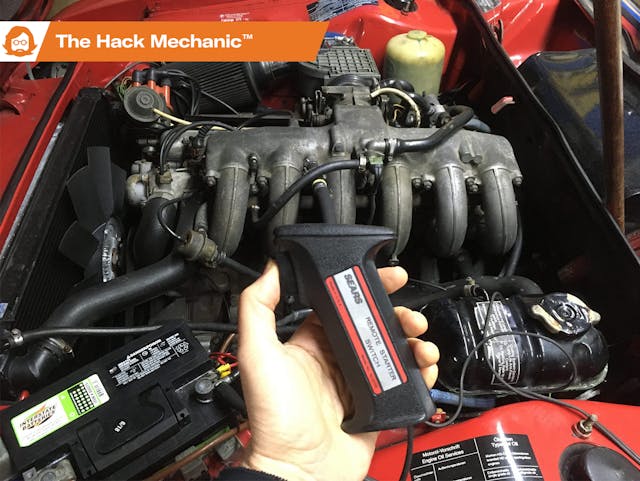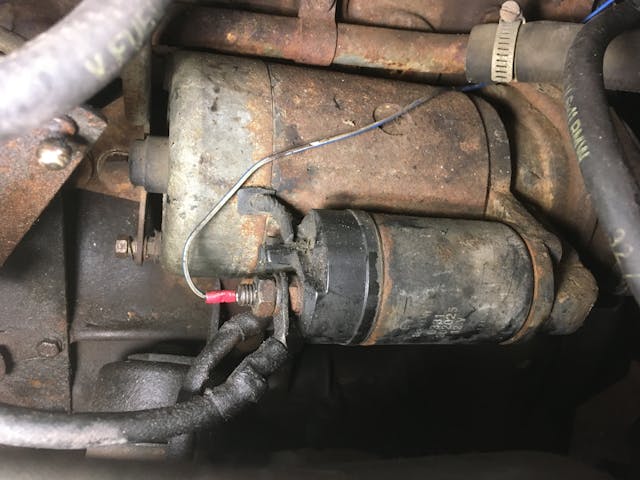If you work on old cars, a remote starter switch is worth every penny

There’s an inexpensive little tool that gets used all the time while trouble-shooting car-won’t-start problems—the remote starter switch. I’m not referring to something electronic on your key fob that starts your car from the comfort of your warm kitchen. No, this is way more old-school than that, and the “remote” part is really something of a misnomer. It’s a physical switch with wires that lets you start the car from under the hood instead of having to crack the key from inside the car.
Why is that important? Is it really that big of a deal to walk three feet, reach inside the car, and twist the key? Well, in fact, yes, sometimes it is. For example, if a car won’t start after a winter’s layup because the fuel has evaporated from the carburetor’s float bowl and the mechanical fuel pump is weak, you may need to give it a few blasts of starting fluid to help things along, and starting fluid is way more effective if it’s being sprayed directly down the throat while the engine is cranking. You’d need the arms of Clyde the orangutang in Every Which Way But Loose to be able to spray and turn the key at the same time.
To understand how a remote starter switch works, you first need to understand the fundamentals of the starter and solenoid.
The starter motor that’s bolted to the engine block is the thing that actually spins your engine while fuel and air are sucked or squirted in and spark is supplied to ignite the mixture. However, the starter’s faithful companion, the solenoid, handles the electrical connections and provides the mechanical interface to the toothed ring on the edge of the flywheel, which is the part that’s actually being turned by the starter.

The starter solenoid is a special type of electrical relay. If you’re not familiar with relays, they’re remote-controlled electrical switches that use an electromagnet to pull together two switch contacts. The utility of this is clear if you imagine, well, what would be a good example … oh, right. The starter motor. Look at the thickness of that cable connecting the starter to the positive battery terminal. It’s the size of your finger so that it can carry the hundreds of amps needed to run the starter and spin the engine. Do you want a cable that thick running to the back of the instrument switch in the steering column and actually making that electrical contact every time you twist the key? I didn’t think so. So, the switching is performed remotely. A thin wire carrying a small amount of current from the ignition switch energizes an electromagnet, which in turn pulls together two switch contacts that can then pass a lot of current—carried by much thicker wires that can stay in the engine compartment. That’s how all relays work.
(A little more information: The terminals on the low-current side of a standard DIN relay are labeled 86 and 85. On the high-current side, they’re 30 and 87. Connect power to 86 and ground to 85, and it energizes the electromagnet, which pulls the contacts closed, which connects 30 to 87. If 30 is connected to battery voltage and 87 is connected to whatever you want to power, there’s your remote-controlled switch. For the uninitiated, that’s probably clear as mud.)

In general, the term “solenoid” refers to an electromagnetic device that’s specifically designed to translate electric current into linear motion. A solenoid has a metal plunger in a housing surrounded by a coil of wire. When current flows through the wire, it creates a magnetic field that slides the plunger in the housing. Solenoids are often used as electrically controlled valves or actuators, but the cool thing about the “starter solenoid” is that it’s both a solenoid and a relay. That is, when it’s energized, it a) pulls the starter motor’s high-current electrical contacts closed and spins it, but it also b) causes a shaft with a pinion gear on it to slide outward and make contact with the toothed ring on the flywheel. The starter-and-solenoid pair is such a successful piece of design that the patent filed by Robert T. Hull in 1913 shows an illustration that looks pretty much like every starter-solenoid pair I’ve ever laid my hands on.
One of the reasons why many people don’t see the solenoid as a relay is that it doesn’t have the four terminals on it like a relay—it only has two. But that’s because the solenoid and the starter are both grounded to the engine block, so they don’t need the two ground terminals. Turning the ignition key to “start” sends 12V to the little terminal on the starter solenoid. This is just like sending 12V to terminal 86 on a relay. The solenoid is grounded, so 12V on the little terminal energizes its electromagnet, which a) closes the contact between what’s connected to the big terminal (the positive battery cable) and ground, and b) thrusts out the shaft which engages the pinion gear with the flywheel. Together, these cause the starter motor to spin the engine, and if the engine has gas and spark, it starts.
Where were we? Remote starter switch. Right. You may have read that if the keyed ignition switch has gone bad—and turning the key doesn’t engage the starter—you can use a screwdriver to “jump” the starter solenoid. The idea is that you use the shaft of the screwdriver to make electrical contact between the big connector from the positive battery terminal and the little connector to the solenoid. I really don’t recommend this, as it’s far too easy to touch the screwdriver’s shaft to ground, which will generate a shower of sparks, and may burn your hand and damage the car’s wiring. It’s far preferable to simply take a length of wire with an alligator connector on it, connect it to the small terminal on the solenoid, and touch the other end to battery positive.

Which is exactly what a remote starter switch is doing. All that they are is a switch—either pistol-grip or push-button—with two wires with alligator clips on the ends pre-connected to it. You attach one clip to battery positive, the other to the small terminal on the solenoid from the ignition switch, and push the button. It supplies 12V to the little terminal on the solenoid, and the engine spins. Simple.
Because the solenoids on all my cars have a quick-connect male spade terminal for the ignition switch connection, I cut the alligator clip off one of the wires from my switch and crimped on a female spade. That makes it much easier to slide it on.


In addition to being able to crank while spraying starting fluid, another frequent use of the remote starter switch is in verifying the presence of spark. That is, it’s easy to say “Have someone crank the engine while you hold a plug wire 1/4-inch from ground and look for spark” if you have someone to crank the engine, but it’s challenging if you don’t. Whenever I go on a road trip, I bring the remote starter switch with me precisely so, if the car dies, I can easily check for spark myself.
Another useful application is in setting ignition dwell. On a vintage car with points, this is an iterative procedure where you connect the dwell meter, start the car, take a reading, shut the car off, remove the cap and rotor, adjust the point gap, put the cap and rotor back on, and try it again. If you have a remote starter switch, you can leave the cap and rotor off, hit the switch to crank the starter, read the dwell while the engine is spinning, stop, tweak the point gap, and then try it again, all much quicker than taking the cap and rotor on and off and starting and stopping the car each time.
You do need to be aware of a few things. First, obviously, it’s crucially important on a car with standard transmission to verify the car is in neutral with the handbrake on and the wheels chocked. Second, when you use a remote starter switch with the intent of generating spark or starting the car, you need to turn the ignition key to the “start” setting to energize the coil. And lastly, it’s generally a good idea to keep the time that the key is in the ignition position without the engine actually running relatively short, as, on vintage cars, the coil, condenser, and points are designed to be pulsed on and off, not to have the current flowing continuously through them. This is similarly true on vintage cars with retrofitted electronic ignition modules. But minutes of troubleshooting at a time should be fine.
Remote start switches are cheap—less than 20 bucks. Really, if you troubleshoot old cars, there’s no reason not to have one.
And yes, since a starter solenoid is a relay and a relay is a remote switch, when you use a remote starter switch on a starter solenoid, you’re using a remote switch on a remote switch.
I suppose that, with long enough cables, I could start one of the cars from the comfort of my warm kitchen. Nah, I’d have to get my hands greasy to unhook them and hook the original ignition switch wire back up. Never mind. Still, I don’t know … maybe a Bluetooth version might be patent-worthy, right?
***
Rob Siegel’s new book, The Best of the Hack MechanicTM: 35 years of hacks, kluges, and assorted automotive mayhem, is available on Amazon. His other seven books are available here, or you can order personally-inscribed copies through his website, www.robsiegel.com.


..